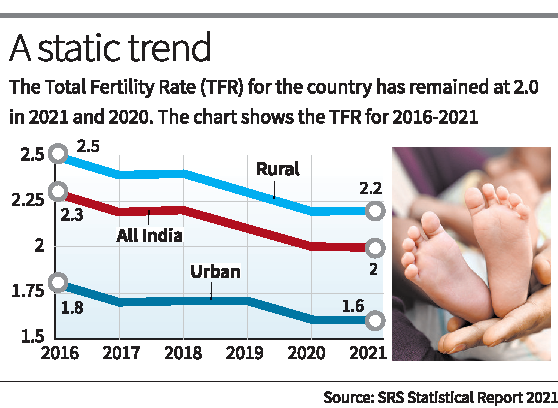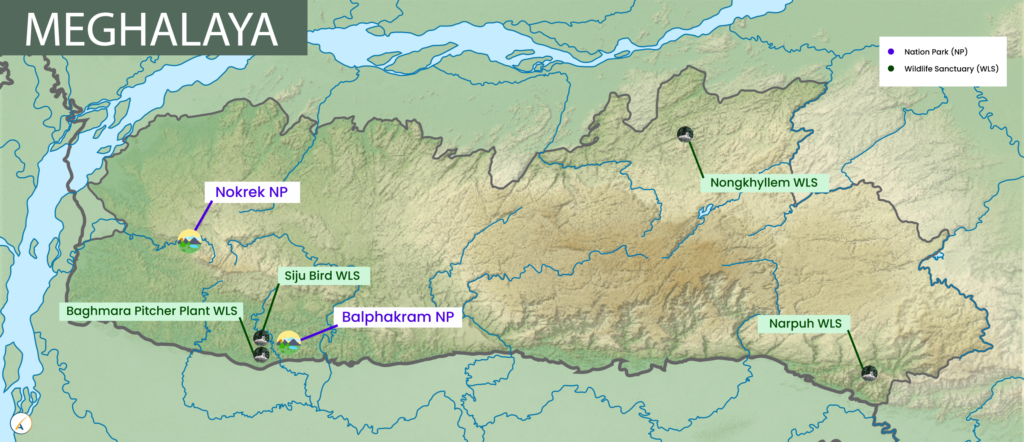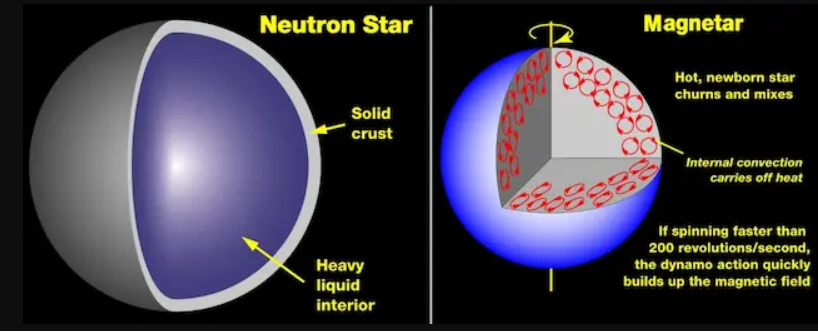Society
Total Fertility Rate in India remains at 2.0; Bihar records highest count, Bengal lowest - The Hindu
The Total Fertility Rate (TFR), the average number of children born to women over their lifetime, in the country has remained at 2.0 in 2021, the same as in 2020, shows the Sample Registration System (SRS) report for 2021 released by the Registrar-General of India (RGI) recently.

SRS Report Highlights
- Highest TFR: Bihar (3.0).
- Lowest TFR: Delhi and West Bengal (1.4).
- National TFR: It reached the replacement level of 2.1.
- Declining Child Population: Share of 0–14 age group dropped from 41.2% (1971) to 24.8% (2021).
- Increase in Working-Age Population: 15–59 age group rose from 53.4% to 66.2% between 1971 and 2021.
- Rising Elderly Population:
- 60+ age group increased from 6% to 9%.
- 65+ age group increased from 5.3% to 5.9%.
- Highest elderly population:
- Kerala: 14.4%
- Tamil Nadu: 12.9%
- Himachal Pradesh: 12.3%
- Lowest elderly population:
- Bihar: 6.9%
- Assam: 7%
- Delhi: 7.1%
- Marriage Age: Mean female age at marriage increased from 19.3 (1990) to 22.5 years (2021).
- States Achieving Replacement Level TFR (2.1 or below): Delhi, West Bengal, TN, Andhra Pradesh, J&K, Kerala, Maharashtra, Punjab, Himachal Pradesh, Telangana, Karnataka, Odisha, Uttarakhand, Gujarat, Haryana, Assam.
World Affairs
All about IMF loan to Pak, why latest tranche was passed - Indian Express
In the light of Pakistan’s military escalation against India, New Delhi conveyed its “strong dissent” to IMF’s decision. For its part, India abstained from voting in the meeting.
Extended Fund Facility (EFF)
- About: An IMF lending programme designed for countries with medium-term balance of payments issues caused by structural economic weaknesses.
- Structural issues: Poor infrastructure, low human capital, weak financial systems, or excessive public debt.
- Nature of Assistance: Not a grant or financial aid; it is a loan that must be repaid.
- Meaning of “Extended”:
- Longer duration for programme implementation.
- Extended repayment period to allow for economic reforms.
- Helps recipient countries:
- Stabilise their economy.
- Implement structural reforms for long-term growth.
- Address external payment imbalances.
Economic Context and Eligibility
- Stagnant GDP: Pakistan’s GDP has remained flat, with 2023 GDP ($338 billion) lower than in 2017.
- High Inflation: Inflation surged from 10.7% (2020) to 29.1% (2023) and 23.4% (2024), reducing purchasing power.
- Rising Indebtedness: Driven by poor governance, high population growth, low savings, poor infrastructure, and low female workforce participation.
- Repeated Borrowing: Received 28 IMF loans in 35 years; also borrowed from China, UAE, Saudi Arabia, ADB, Paris Club, etc.
Why IMF Approved the Latest EFF Tranche
- Positive Policy Review: IMF found Pakistan’s reforms under EFF effective in stabilising the economy.
- Key Improvements:
- Borrowing levels reduced.
- Inflation dropped to 0.3% in April.
- Disinflation trend observed.
- Foreign exchange reserves improved.
- Fiscal Reforms: Adoption of FY2025 budget and Agricultural Income Tax helped regain policy credibility.
Economy
How is Kerala handling its waste problem? - The Hindu
In a five-day conclave, titled ‘Vruthi 2025: The Clean Kerala Conclave’ held at Thiruvananthapuram recently, in which around 25,000 people participated, it was stated by the Local Self-Government Minister that the State had reached formidable success in waste collection from houses — around 75% of houses have been reached, which was just 40% till a year back.
Need for the Campaign
- Urbanisation Impact: Post-liberalisation consumerism increased non-biodegradable waste in Kerala, straining traditional backyard disposal systems.
- Health and Hygiene Crisis: Accumulation of waste led to localised environmental degradation and health concerns.
- Civil Aspirations: Waste management remains a key concern among aspiring civil servants and citizens.
- Historical Parallel: Like the urban reforms during the plague in England, Kerala’s waste campaign is driven by health concerns.
Campaign Initiatives
- ‘Malinya Muktham Nava Keralam’: High-profile campaign involving all local self-governments and stakeholders to achieve garbage-free Kerala.
- Public Engagement: Civil society participation, cultural activities, school and youth involvement, and competitive targets among local bodies.
- Inter-agency Collaboration: Triggered by public health incidents, various government bodies and departments collaborated for cleaner public spaces.
Difference from Swachh Bharat Mission
- SBM: Top-down, infrastructure-focused, supply-driven.
- Kerala Campaign: Behaviour-centric, participatory, technology-neutral and customisable, promoting decentralised solutions.
Centralised vs Decentralised Debate
- No Binary Approach: The conclave recommended learning from both models.
- Successes and Failures:
- Centralised: Guruvayur (success), Kochi (failure).
- Decentralised: Limited by local capacities despite increased funding.
- Policy Recommendation: Professionalisation of urban services is essential.
Way Forward
- Sustainability Concern: The campaign’s success is state-driven; long-term results depend on continued momentum and local ownership.
- Extended Producer Responsibility (EPR): Needs strengthening to shift waste responsibility to producers.
- Behavioural Shift: 'My waste, my responsibility' should be institutionalised at all levels of society.
Importance of Building Collectives
- Institutional Support: Schools, RWAs, businesses, and worker unions must actively participate.
- Model for India: Kerala’s holistic, participatory approach could serve as a replicable model for sustainable waste management nationwide.
Why farmers prefer rice, wheat - Indian Express
Farmers, like all businessmen, are rational and risk-averse. Everything else being the same, they will choose to grow crops that offer reasonable price as well as yield assurance.
Rationale Behind Crop Choice
- Profit motive: Farmers, like entrepreneurs, prefer crops with assured returns and lower risks.
- Reasons for preferring rice & wheat: High yield, price assurance, and irrigation support.
- MSP procurement by the government: It further incentivises their cultivation.
- Acreage Trends (2015–2025):
- Punjab (Rice): Increased from 29.8 to 32.4 lakh hectares.
- Telangana (Rice): Rose from 10.5 to 47 lakh hectares.
- Madhya Pradesh (Wheat): Increased from 59.1 to 78.1 lakh hectares.
- Madhya Pradesh (Rice): Increased from 20.2 to 38.7 lakh hectares.
- Decline in Other Crops:
- Cotton in Punjab: Dropped from 3.4 to 1 lakh hectares.
- Chana in MP: Declined from 30.2 to 20.1 lakh hectares.
- Soybean in MP: Fell from 66.7 (peak) to 57.8 lakh hectares.
- Factors Favouring Wheat & Rice:
- Green Revolution varieties improved yields and resistance:
- HD-3385 (Wheat, 2023): 6 tonnes/ha average yield, resistant to rusts, adaptable to multiple sowing windows.
Rice advancements:
- Kamala (GE Samba Mahsuri): 5.37–9 tonnes/ha, matures in 130 days, high grain count, better nutrient efficiency.
- Pusa DST Rice 1: Tolerant to drought, salinity, alkalinity.
- Technological Gaps in Other Crops
- Cotton: No major breeding innovation post Bt cotton (2002–06).
- Oilseeds and pulses: Stagnant or marginal yield growth.
- Lack of approved GM technologies in crops like mustard, brinjal.
- Implications:
- Continuous R&D, irrigation, and MSP support make rice and wheat more attractive.
- Direct seeding and short-duration hybrids in rice enhance productivity and water-use efficiency.
- In contrast, other crops suffer from market uncertainty, limited R&D, and policy neglect, leading to acreage volatility.
Environment
Meghalaya group opposes ecotourism project in wildlife sanctuary - The Hindu
A youth organisation has opposed an ecotourism development project in Meghalaya’s Nongkhyllem Wildlife Sanctuary, citing a potential threat to its delicate ecosystem.
Nongkhyllem Wildlife Sanctuary

- Location: Located in Ri-Bhoi district, Meghalaya.
- Terrain: Part of the Eastern Himalayan Global Biodiversity Hotspot.
- Landscape: Includes undulating plains, low hills, and rugged terrain shaped by the Umtrew River and its tributaries (Umran, Umling, Umtasor).
- Hydrology: Umtrew River forms the western boundary of the sanctuary.
- Fauna: Hosts 400+ bird species, including the endangered Rufous-necked Hornbill.
- Key mammals: Clouded Leopard, Elephant, Himalayan Black Bear.
- Dominant trees: Shorea robusta, Tectona grandis, Terminalia myriocarpa, Gmelina arborea.
- Legal Status: Declared a sanctuary in 1981 under the Wildlife Protection Act, 1972.
- Recognition: Rated best-managed protected area in Northeast India in the 2021 MEE Report.
Sci and Tech
Asteroid YR4 might miss earth; will it miss the moon, too? - The Hindu
Scientists used the ATLAS telescope in Rio Hurtado, Chile, to discover asteroid 2024 YR4 in December 2024 as a new entrant in the asteroid databases — and it made a splash. Since its discovery, it has kept planetary defence scientists on their toes because of the possibility that it could collide with the earth someday.
YR4
- About: A near-Earth asteroid, orbiting the Sun within 1.3 times the Earth-Sun distance.
- Size: Initially estimated to be >140 m (potentially hazardous threshold), later confirmed by James Webb Telescope to be 65 m wide (10-storey building size).
How Impact Risks Are Calculated
- Observatories use radar and telescope images to track asteroid paths.
- Initial orbits are uncertain, leading to multiple impact possibilities.
- New data improves orbital models and reduces uncertainty.
- NASA Sentry uses the Torino Scale to rate impact threat (0 = no risk, 10 = catastrophe). YR4 was rated 3, later downgraded.
Potential Moon Impact
- If YR4 hits the moon, it could create a 500–2,000 m crater.
- Energy released: 340 times the Hiroshima bomb.
- Chandrayaan-2 and other orbiters may capture the impact.
Will It Be Visible?
- Visibility from Earth is debated.
- Some say the impact flash may be visible even in daylight.
- Could offer scientific insights into lunar surface composition.
Future Observations and Risks
- YR4 will pass Earth again in 2028, allowing more precise observations.
- Even though ruled out as a threat now, asteroid impacts remain a danger (e.g., Chelyabinsk 2013).
- Large impacts could cause climate disruption for years.
In remains of 2004 flare, scientists find second natural source of gold - The Hindu
The first direct observational evidence of a process called r-process nucleosynthesis was recently observed in a powerful flare emitted by a body called a magnetar in 2004. Almost a day after the flare, the magnetar emitted strong gamma rays, which NASA’s Compton Gamma Ray Observatory recorded.
Magnetars

- About: A type of neutron star with extremely strong magnetic fields, about 1,000 times stronger than typical neutron stars.
- R-Process Nucleosynthesis: A rapid neutron-capture process forming heavy elements like gold, platinum, uranium.
- Conditions: Requires extreme conditions and neutron-rich matter.
- Significance:
- Suggests magnetars may have created heavy elements much earlier than neutron star mergers.
- Offers insights into galactic chemical evolution and the origin of heavy elements in the universe.